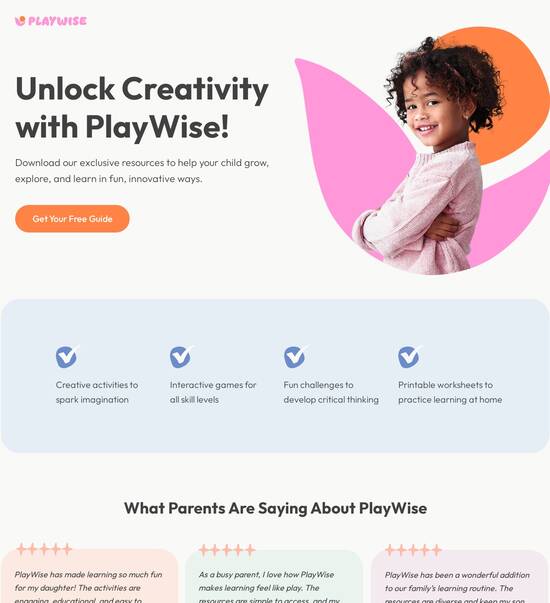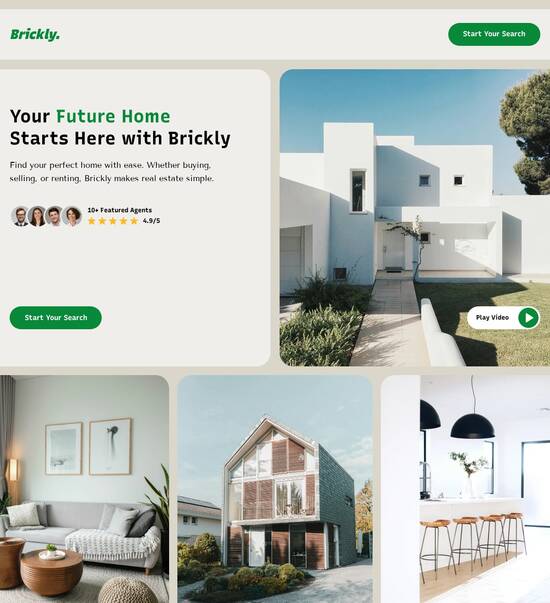
Bootstrap optimized checkout page template
Explore Similar TemplatesAbout template
Supercharge your checkout page with Bootstrap for outstanding performance! Learn more today.
Recommended templates

Easy to build without coding
With the intuitive drag-and-drop builder, anyone on your team can create high-converting pages without any knowledge of code or design. Make enhancements to your landing page with custom widgets using Javascript, HTML/CSS, or third-party scripts.

Multiple layouts for any industry and goal
Select from 500+ landing page layouts built to boost conversions across industry-specific scenarios. Customize them by adjusting fonts, adding images, and generating on-brand content with the AI assistant. Quickly scale with Instablocks® and Global Blocks that you can save, reuse, and update globally.

Loads fast and looks polished on any device
Every template is responsive, which means they present professionally on any device and load blazingly fast with our Thor Render Engine. You can also power them up with Google AMP technology to deliver an unparalleled mobile experience and drive higher conversions.

Robust analytics & experimentation
Get real-time updates and reporting across all your devices, showing the number of visitors, conversions, cost-per-visitor, and cost-per-lead. Launch AI-powered experiments, run A/B tests, and use heatmaps to analyze user behavior, then optimize your landing page to maximize conversions.







Easy to build without coding
With the intuitive drag-and-drop builder, anyone on your team can create high-converting pages without any knowledge of code or design. Make enhancements to your landing page with custom widgets using Javascript, HTML/CSS, or third-party scripts.
Multiple layouts for any industry and goal
Select from 500+ landing page layouts built to boost conversions across industry-specific scenarios. Customize them by adjusting fonts, adding images, and generating on-brand content with the AI assistant. Quickly scale with Instablocks® and Global Blocks that you can save, reuse, and update globally.
Loads fast and looks polished on any device
Every template is responsive, which means they present professionally on any device and load blazingly fast with our Thor Render Engine.
Robust analytics & experimentation
Get real-time updates and reporting across all your devices, showing the number of visitors, conversions, cost-per-visitor, and cost-per-lead. Launch AI-powered experiments, run A/B tests, and use heatmaps to analyze user behavior, then optimize your landing page to maximize conversions.
All the features you need to build lead-generating landing pages
Explore more featuresLearn how to build top-performing landing pages for any goal
FAQs
Leading the way in building high-performing landing pages





Creating high-converting landing pages with Instapage
Instapage provides marketers with exceptional tools to design and optimize landing pages that drive conversions. Its emphasis on user experience and data-driven decisions allows businesses to capture leads effectively and boost ROI across various marketing campaigns.
Why choose Instapage for landing pages?
With over 100 high-converting templates available, Instapage stands out in the crowded marketplace. Each template is optimized for specific goals, allowing you to select a layout that resonates with your target audience, whether you are in business services, tech, or education.
- 100+ customizable templates: Instapage's library includes diverse templates tailored for different industries, benefiting companies in sectors such as finance and government.
- No coding required: Marketers can easily craft landing pages without needing developer assistance, ensuring you can go live with necessary edits swiftly.
- Built-in heatmaps and A/B testing: These features allow you to analyze user behavior on your pages, facilitating well-informed improvements.
Step 1: Selecting the right template
Start by choosing a template that aligns with your campaign objectives. Follow these tips to ensure the best fit:
- Identify your goal: Determine if the landing page is for lead generation, product launch, or capturing survey responses.
- Consider your audience: Choose a design that speaks directly to the demographics you aim to engage, such as tech-savvy individuals or educators.
- Test different templates: Utilize Instapage's A/B testing features to see which template performs best.
Step 2: Customizing your content
Once your template is selected, tailor the content to enhance engagement. This includes adding personalized elements that speak to your audience's needs.
- Dynamic text replacement: Use personalized messaging that resonates with each user, improving conversion rates exponentially.
- Integrate AdMaps: Align ads with the tailored landing pages for effective remarketing strategies.
- Utilize visuals: Incorporate relevant images or videos that speak to the visitor’s experiences, enhancing understanding and appeal.
Step 3: Optimizing for performance
After creating your landing page, ensure you optimize it for the best performance. Here are critical practices:
- Implement analytics tracking: Monitor how users interact with your page to adjust strategies based on actual performance metrics.
- Conduct continuous A/B testing: Regularly test different elements of your pages, such as CTA buttons and headlines, to determine what works best.
- Review heatmapping insights: Analyze where users are clicking and scrolling to modify the layout and improve user journeys.
By following these steps, marketers can effectively leverage Instapage's features for creating high-performing landing pages that drive conversions and enhance user experience.
Get started with Instapage today to unleash the full potential of your digital marketing efforts and maximize your ROI!
People also ask about Bootstrap optimized checkout page template
Optimizing the Checkout Experience: The Role of Bootstrap Checkout Page Templates
Understanding Bootstrap framework for checkout pages
Bootstrap is a powerful front-end framework used widely for developing responsive and visually appealing websites. It was created to simplify the web development process by providing pre-designed components and a grid system that adapts to different screen sizes. With its mobile-first approach, Bootstrap ensures that websites look great on any device, eliminating the hassle of custom designs for each platform.
The importance of Bootstrap in responsive web design cannot be overstated; it allows businesses to streamline their web development while ensuring an optimal user experience. Specifically for e-commerce, a well-designed checkout page is critical for converting visitors into shoppers. With Bootstrap, developers can create checkout pages that not only meet business needs but also enhance customer satisfaction.
Flexibility in design: Bootstrap provides a grid system that allows for easy rearrangement of elements to suit different layouts.
Built-in components tailored for e-commerce: With elements like modals, carousels, and alerts, Bootstrap simplifies the integration of necessary features for an effective checkout experience.
User-centric design: Enhancing the shopping experience
User experience (UX) plays a pivotal role in the checkout process. A smooth and intuitive experience can significantly impact purchasing decisions. When shoppers encounter a user-friendly checkout page, they feel more confident and are likely to complete their transactions. Conversely, a complicated UX can lead to frustration and cart abandonment. Therefore, focusing on both interface design and user interactions is crucial for maximizing sales.
Furthermore, understanding different shopper personas is essential in tailoring checkout pages. Each user demographic can have varying preferences, and offering personalized options can boost conversion rates. By analyzing behavior patterns and preferences, businesses can create checkout experiences that cater specifically to their customers, thereby enhancing satisfaction.
Identify key shopper personas to tailor experiences effectively.
Implement personalized offers and suggestions during the checkout process.
Utilize user feedback to refine interface elements and interactions continually.
Responsive design: Catering to all devices and screen sizes
As consumer habits shift increasingly to mobile, businesses face the challenge of ensuring that their checkout experiences are optimized for all devices. Users shop with different screens, from smartphones to tablets to laptops, and their expectations of seamless experiences drive the need for adaptability in the checkout flow. Therefore, having a responsive design powered by Bootstrap is critical.
Bootstrap simplifies the implementation of responsive elements through its grid system. This allows developers to effortlessly rearrange components based on the user's screen size, creating a more efficient checkout experience. Additionally, media queries can be applied to ensure that every aspect of the checkout page adjusts intuitively, enhancing usability for every customer.
Analyze user behavior across various devices to inform design choices.
Utilize Bootstrap's grid system for flexible layout management.
Test responsiveness across devices regularly to enhance customer satisfaction.
Crucial components of an optimized checkout page
A successful checkout page incorporates several essential elements that work in unison to create a streamlined purchasing process. First, strategic placement of the header and logo reinforces brand identity, helping customers feel secure and confident in their choice. Furthermore, properly designed form fields improve user input efficiency, potentially reducing cart abandonment rates.
In addition to these foundational elements, incorporating progress indicators and feedback mechanisms is vital in guiding users through the checkout journey. Including visual cues and instructions enables customers to understand where they are in the process and what steps remain. Designing loaders and confirmation messages is also crucial for reassuring shoppers and enhancing the overall transaction flow.
Use clear navigational elements to guide users effectively.
Implement well-structured form fields that minimize user fatigue.
Create visual cues like progress indicators to improve user comprehension.
Streamlining the checkout flow: Minimizing friction points
Many users abandon their shopping carts due to common checkout obstacles such as lengthy forms, unexpected fees, or confusing navigation. Understanding these psychological barriers is essential in optimizing the checkout experience. It’s imperative to identify friction points and implement solutions that alleviate user concerns while simplifying the checkout process.
One effective strategy for reducing friction is to simplify navigation and form fields. Incorporating autofill features for returning users can streamline filling out necessary information, making it easier for them to complete purchases. Moreover, providing clear information about fees and delivery times can build trust and keep users engaged.
Identify and address common checkout points of abandonment through testing.
Simplify navigational elements to enhance usability.
Incorporate autofill options for registered users to expedite checkout.
Security features: Building trust throughout the checkout process
In the realm of e-commerce, security plays a crucial role in influencing user experience. A secure checkout process is essential in converting visitors into loyal customers. Users must feel confident that their personal and financial information is protected during transactions. Highlighting the use of SSL certificates and secure payment gateways can vastly improve customers' perception of your site’s credibility.
Moreover, integrating secure credit card processing options can reassure customers about the safety of their financial data. Best practices include displaying security badges prominently on the checkout page to communicate trustworthiness visually. By stringently adhering to security protocols, businesses can foster customer loyalty and encourage repeat patronage.
Ensure SSL certificates are in place and clearly indicated on the page.
Provide secure payment options to cater to diverse user preferences.
Incorporate trust symbols and security badges on the checkout page.
Customization and branding: Aligning checkout pages with websites
Brand consistency is essential across all customer touchpoints, particularly at the checkout stage. Maintaining a cohesive aesthetic ensures that users feel a sense of familiarity and trust as they complete their transactions. Bootstrap templates can be tailored to reflect a business’s unique identity, ensuring that the checkout process aligns with the overall branding.
Furthermore, customizing Bootstrap checkout templates can elevate the shopping experience. Tools such as CSS and JavaScript allow for unique design elements to be integrated without extensive coding knowledge. Additionally, using plugins and widgets can significantly enhance functionality, providing users with a personalized and engaging shopping experience.
Implement consistent branding elements such as logos, colors, and fonts.
Leverage CSS and JavaScript for deeper customization without heavy coding.
Explore available plugins and widgets for added functionality.
Testing and iterating: The path to continuous improvement
Once a checkout page is live, the journey toward optimization doesn’t end. Implementing A/B testing strategies can provide key insights into how users are interacting with various elements of the checkout process. By testing different UI components and layouts, businesses can gauge which features contribute to higher conversion rates and make informed adjustments.
Moreover, collecting user feedback post-purchase can offer invaluable insights into enhancing the user experience. Techniques like surveys or user interviews can unveil pain points and areas for improvement. By continually analyzing data, businesses can optimize their checkout pages and ensure they meet changing customer expectations.
Set measurable objectives for A/B testing to identify successful elements.
Solicit user feedback through surveys and interviews after purchases.
Use data analytics to inform ongoing refinements for future iterations.
Case studies: Successful implementations of Bootstrap checkout templates
Several innovative brands have effectively leveraged Bootstrap checkout templates to enhance their e-commerce offerings. By adopting a user-centric approach, these companies have implemented strategies that significantly improved their checkout processes. Success can be measured in boosted conversion rates, lower cart abandonment, and enhanced user satisfaction.
Examining these case studies offers valuable lessons and best practices that can be adapted to different industries. Key takeaways revolve around the importance of user feedback, the need for continuous testing, and the value of a strong brand presence throughout the checkout journey.
Analyze the strategies of brands that improved their checkout processes.
Learn from specific metrics related to conversion and user satisfaction.
Adapt successful tactics to fit your unique business environment.
Future trends in checkout page optimization
Emerging technologies will keep influencing the checkout experience as the landscape of e-commerce evolves. The integration of artificial intelligence and machine learning stands to revolutionize how businesses personalize shopping experiences, learning and adapting based on user interactions over time. Furthermore, evolving payment methods, including digital wallets and cryptocurrencies, are set to coexist with traditional credit cards, offering users greater flexibility.
To thrive in this dynamic e-commerce environment, businesses must stay ahead of user expectations and technological advancements. By embracing innovative solutions and being adaptable, companies can create exceptional checkout experiences that cater to the evolving needs of their customers.
Stay updated with emerging technologies influencing e-commerce trends.
Anticipate user preferences to enhance checkout experiences.
Integrate new payment methods for a seamless transaction process.
Ready to skyrocket conversions?
Supercharge your ad campaigns with high-performing landing pages
Get started














